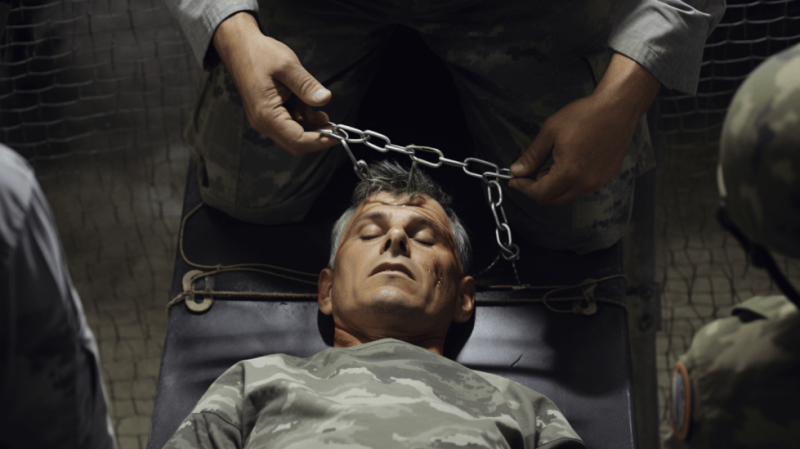How to Survive Waterboarding
Waterboarding is an interrogation technique that has been the subject of much debate and controversy. Its use is often condemned as torture due to its extreme physical and psychological effects on the victim. While it’s unlikely that most people will ever have to face this terrifying experience, it’s important to be prepared for the worst and understand how to survive waterboarding if ever subjected to it.
To better understand waterboarding, it’s essential to be familiar with the process and its history. It has been used by various organizations and governments to extract information from detainees. However, some argue that the information gathered through this technique is unreliable due to the victim’s intense distress. Surviving waterboarding requires a combination of mental preparation, physical tactics, and strategic handling of the interrogator.
Key Takeaways
- Waterboarding is a controversial interrogation technique with a significant impact on the victim’s physical and mental well-being
- Understanding the historical context, ethical debate, and effects of waterboarding is essential
- Employing mental and physical tactics can increase the odds of surviving waterboarding
Understanding Waterboarding
Interrogation Technique
Waterboarding is a controversial interrogation technique that has been widely debated due to its potential to inflict severe physical and psychological harm. It has been used by various governments and organizations to extract information from detainees, sometimes resulting in providing false or misleading information as a way to end their suffering.
Form of Torture
Regarded as a form of torture by many international bodies and governments, waterboarding has caused significant harm to detainees subjected to it. The United Nations Convention Against Torture and other international human rights treaties have clearly stated that waterboarding constitutes torture and should not be utilized.
Post-Traumatic Stress
Survivors of waterboarding often suffer from post-traumatic stress, depression, and other long-lasting psychological disorders. The enduring psychological trauma is a testament to the severity of this torture technique.
Sensation of Drowning
The core principle of waterboarding is to induce the sensation of drowning without causing actual death. By immobilizing an individual and forcibly pouring water over their face, it triggers a reflexive panic response, causing them to experience extreme fear and stress.
Water Torture
Waterboarding can be considered a modern adaptation of historical water torture methods designed to psychologically break an individual. Variations of water torture have been practiced throughout history, demonstrating the long-lasting consequences of this brutal technique.
Process of Waterboarding
The process of waterboarding typically involves restraining an individual on their back, covering their face with a cloth, and periodically pouring water over their nose and mouth. This causes the person to experience difficulty breathing, inducing fear and panic. The process can be repeated multiple times to increase the stress and panic experienced by the individual.
Torture Techniques
Waterboarding is only one of several torture techniques that have been used throughout history to inflict physical and psychological harm on individuals. Other methods include sleep deprivation, extreme cold or heat exposure, and solitary confinement, among others. These techniques have been shown to cause long-term psychological issues in addition to the immediate physical distress experienced by the victims.
Purpose of Waterboarding
The supposed purpose of waterboarding is to extract information from uncooperative individuals, but in many cases, it only serves to induce false confessions or inaccurate information. The intense fear and stress experienced by the victim often leads them to say anything to end the torture, compromising the quality of the intelligence obtained. Furthermore, the use of waterboarding has tarnished the reputations of governments and organizations employing this technique, further undermining its effectiveness.
As I dive deeper into the subject of waterboarding, my understanding has grown regarding its devastating effects on both the individual subjected to it and the broader consequences it has on human rights and international relations. Learning about waterboarding has motivated me to continue advocating for the prevention of torture and the protection of human rights for all individuals.

Historical Context
World War II
During World War II, waterboarding was practiced by both Japanese and German officials. This brutal form of torture was employed to extract information from prisoners and create an atmosphere of fear. Though it was a small part of the atrocities committed during the war, its terrible legacy still remains with us today.
Vietnam War
In the Vietnam War, waterboarding was used by the United States military as a method of torture. This war brought a new level of attention to the issue, as many opponents of the war saw it as a violation of human rights. Despite this criticism, waterboarding continued to be practiced, further cementing its place in the history of wartime torture techniques.
Guantánamo Bay
Guantánamo Bay is perhaps the most infamous location where waterboarding has been used in recent history. The detainees held at this U.S. military prison were subjected to a variety of inhumane treatment methods, including waterboarding. This practice has been heavily criticized by numerous human rights organizations and has led to increased scrutiny of the United States’ interrogation techniques.
War Crime
Waterboarding is considered a war crime by many international bodies because of its capacity to inflict severe mental and physical suffering. The torturous aspect of this practice, coupled with its use during conflicts such as World War II, the Vietnam War, and at Guantánamo Bay, has cemented its reputation as a brutal and inhumane method of interrogation. While I understand the debate surrounding its use as a means of gathering information, the evidence shows that waterboarding is deeply unethical and causes untold suffering for its victims.
Public Figures and Waterboarding Debate
Khalid Sheikh Mohammed
I discovered in the course of my research that Khalid Sheikh Mohammed, the mastermind of the 9/11 attacks, was subjected to waterboarding by US officials. His case represents one of the most controversial instances surrounding the waterboarding debate, leading to discussions and arguments on whether the technique should be characterized as torture in the American debate.
Dick Cheney
Former Vice President Dick Cheney has been a prominent figure in the waterboarding debate, often defending its use as a necessary counterterrorism measure. He has maintained that the technique, which simulates drowning, has been effective in preventing further terrorist attacks and is not considered torture.
Malcolm Nance
Malcolm Nance, a combat veteran and former chief of training at the US Navy Survival, Evasion, Resistance, and Escape School, offers a different perspective on waterboarding. He points out that waterboarding is, indeed, torture. His stance is based on his personal experience and knowledge of the psychological and physical damage that the technique can inflict on individuals. Malcolm is against using euphemisms like “enhanced interrogation” to describe waterboarding, as he believes this attempts to rationalize and sanitize the act of torture.
Dr. Paul Chabot
Dr. Paul Chabot is another important figure in the waterboarding debate, providing information on how to survive waterboarding. His advice demonstrates that waterboarding can be a life-threatening experience, further fueling the debate on whether it should be considered torture. Dr. Chabot’s survival tips include recognizing the gravity of the situation, managing panic, and focusing on breathing techniques to withstand the ordeal.
In this section, I have presented the differing viewpoints and perspectives of several key public figures in the waterboarding debate, from those who defend its use as a counterterrorism measure, to those who argue that it should be classified as torture. The debate remains a contentious issue, with both sides presenting compelling arguments and evidence.

Surviving Waterboarding
Mental Readiness
One of the most critical aspects of surviving waterboarding is mental readiness. As a technique designed to induce fear and break you psychologically, you must maintain a strong mental resolve throughout the ordeal. It’s essential to practice relaxation techniques, such as progressive muscle relaxation, mindfulness meditation, or yoga before any potential situation. These practices can help you remain calm and focused, which will make all the difference in your ability to endure this extreme form of torture.
Deep Breaths
Taking deep breaths is crucial in managing the physical stress associated with waterboarding. Before any simulation or actual event, practice taking deep, slow breaths and focus on controlling your breathing. Doing so can help your body maintain a semblance of normalcy and keep you calmer during the process. When waterboarding occurs, try your best to take deep breaths in between the water being poured on your face to maximize the air intake and reduce the likelihood of panicking.
Breath-Holding Ability
Improving your breath-holding ability can significantly increase your chances of surviving waterboarding. The more you can hold your breath, the less impactful the water will be in causing asphyxiation. To enhance this skill, consider activities such as swimming or practicing breath-holding exercises. Remember, it is important not to push too hard or cause harm during these practices, but gradually increase your ability through consistent effort.
Panic Attack
During waterboarding, you might experience a panic attack due to the intense nature of this technique. Recognize that fear and panic are normal responses, but you must learn how to control them as best you can. Techniques like visualizing a safe place or focusing on a specific memory can help you cope with the overwhelming fear. Additionally, try tapping into your existing relaxation practices to manage the panic and maintain a level of calm in this terrifying situation.
In summary, my best advice for surviving waterboarding is to focus on mental readiness by mastering relaxation techniques, practicing deep breaths, improving your breath-holding ability, and learning to control panic attacks during this challenging and terrifying experience. Maintain a clear and confident mindset, and remember that your mental fortitude will be your greatest asset.
The Ethical Debate
Human Rights
As I explore the topic of waterboarding, it’s important to consider the ethical implications of this practice. One key element is its relation to human rights. Waterboarding has been labeled as a form of torture, with critics arguing it violates the fundamental rights of the individual. Amnesty International describes waterboarding as slow-motion suffocation and those who learn about it generally find it horrific.
Geneva Convention
The legality of waterboarding also comes into question under international law, specifically the Geneva Convention. Waterboarding, as a form of torture, stands in direct conflict with the principles set forth in the Geneva Convention, which prohibits cruel, inhuman or degrading treatment. This is crucial in understanding the divisive nature of the practice and its place in the ethical debate.
Controversial Subject
Waterboarding has been a controversial subject, especially within the United States. The debate escalated during the Bush Administration, where waterboarding was downgraded and employed as part of the so-called “War on Terror”. This has led to extensive discussion on the appropriateness of waterboarding and whether it aligns with the moral standards that the United States wishes to uphold. The subject remains contentious, and the ethical debate plays a significant role in forming opinions on the practice.
In my exploration of waterboarding and its survivability, keeping these ethical considerations in mind is crucial, as they provide valuable context and insight into the practice’s standing on both national and international levels. While waterboarding continues to be a controversial topic, understanding the human rights, legal, and moral implications behind it is essential.

Effects of Waterboarding
Psychological Effects
Waterboarding can have significant psychological effects on a person. The feeling of drowning and being unable to breathe can create extreme fear and anxiety, leading to lasting trauma and stress. Many individuals who have experienced waterboarding report ongoing nightmares, flashbacks, and a lingering sense of helplessness. Furthermore, the psychological damage can manifest in symptoms such as depression, anxiety disorders, and post-traumatic stress disorder (PTSD).
Brain Damage
While waterboarding mainly targets the person’s psychological response, it can also potentially result in brain damage. As the technique restricts the air supply and induces the sensation of drowning, the brain may suffer from a lack of oxygen. Over time, this oxygen deprivation can cause irreversible brain damage, leading to cognitive deficits and even long-term neurological disorders.
Organ Damage
Though not as prevalent as the psychological effects and potential brain damage, waterboarding can cause damage to other organs as well. When a person is subjected to repeated waterboarding sessions, the increased stress and strain on their body may lead to issues with their respiratory, cardiovascular, and other vital systems. Prolonged periods of oxygen deprivation can also result in damage to the heart and lungs. Although organ damage may not be evident immediately, it can emerge as a long-term consequence of the waterboarding experience.
In summary, it is crucial to be aware of the potential dangers and lasting impacts of waterboarding, including psychological effects, brain damage, and organ damage. While the primary aim of this technique is to create immense psychological distress rather than physical harm, the consequences can be severe and long-lasting.
Frequently Asked Questions
What are some techniques to cope with waterboarding?
There are several techniques that can help someone cope with waterboarding, such as mental preparedness, breath control, and giving up some information during the interrogation. These strategies can help you endure the intense discomfort and fear of drowning, which is a key element of waterboarding torture. It’s important to remember that these coping mechanisms are not guaranteed to work, as each person’s response to such a situation may vary. source
Are there physiological responses that can help resist waterboarding?
Physiological responses, such as sharp exhalation once the water stops, can help resist waterboarding to some extent. This allows you to clear your airway and minimize the sensation of drowning. However, one’s body may still involuntarily react to the waterboarding process, which can increase feelings of panic and anxiety. Developing methods to control physiological responses can make a difference, but it’s important to understand that waterboarding is an extremely distressing experience and it may be difficult to control our body’s natural reactions.
How can mental preparedness help with waterboarding?
Mental preparedness is crucial in enduring the distress associated with waterboarding. By understanding the process and anticipating the sensations that come with it, you can form a more controlled response to the ordeal. Visualization techniques and mental conditioning can also help you stay focused and resist the panic that can accompany waterboarding. source
What are the potential risks associated with waterboarding?
Waterboarding can pose significant risks, both physically and mentally. Physically, waterboarding may cause difficulty in breathing, choking, coughing, and even vomiting. Moreover, there’s a risk of aspiration pneumonia or other lung complications, which can be life-threatening. Psychologically, waterboarding can cause severe stress, anxiety, post-traumatic stress disorder (PTSD), and even long-lasting emotional trauma. source
How can breath control affect the experience of waterboarding?
Breath control plays a crucial role in the experience of waterboarding. Proper breath control may help you lessen the feeling of drowning and choking. By focusing on your breathing and developing ways to manage it, you may be able to increase your chances of enduring the waterboarding process. However, it’s essential to remember that breath control alone might not be enough to completely mitigate the experience’s extreme stress.
What is the historical context for the use of waterboarding?
Waterboarding has been used as a form of torture for centuries, dating back to the Spanish Inquisition. Throughout history, various groups, including the military and intelligence agencies, have employed waterboarding as an interrogation technique to extract information from individuals. The act is controversial and has been condemned by many as a form of inhumane treatment that violates international human rights standards and itself is considered a war crime.








